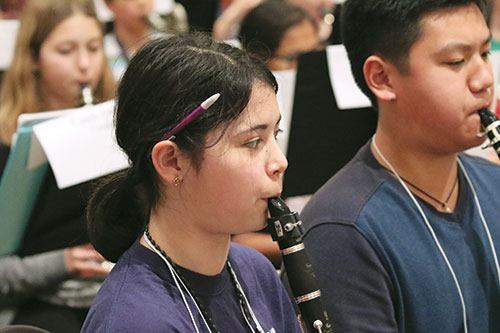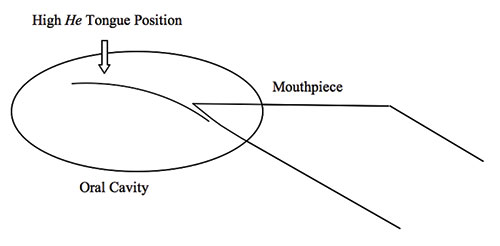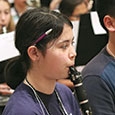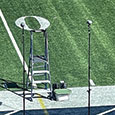A clarinetist’s tongue position is one of the most important components of successful playing, because it directly affects tone, intonation, response, and the ability to articulate quickly. In addition, the ideal clarinet tone – dark, in tune, and focused – can only be produced if the tongue is in the correct position. The optimum clarinet tongue position is one that is comfortable, produces a great tone, provides a quick response in all registers, and places the tip of the tongue close to the reed for quick and clean articulation. It is important for clarinetists to find this position because without it, all areas of clarinet performance will suffer.

Optimum Tongue Position
The optimum clarinet tongue position requires the clarinetist to place the tongue extremely high, to the point that the back of the tongue is close to roof of the mouth and the sides of the tongue actually touch the inner sides of the upper teeth, as if saying he. Using a high tongue position keeps the air stream narrow, focused, highly pressurized, and moving quickly. When this is performed correctly, the air stream will feel cool on the hand rather than warm. In addition to assisting in good tone production, response and articulation, this high tongue position will also assist the clarinetist in playing notes in the altissimo register. Although the tongue position may change slightly when playing the clarinet in different registers, the overall high position should basically stay the same throughout the entire range of the instrument. By using this high tongue position, clarinetists will discover that their tone is more focused, response is better, articulation is quicker and playing the instrument is much easier.

The Swab Exercise
This concept can be a challenge to teach, because no on can see inside them mouth to know if the tongue is positioned correctly while playing. However, there is a playing exercise that will allow clarinetists to know if the tongue is in the correct position and if it is not, allow them to learn to position it correctly. The Swab Exercise is an overtone exercise that, when performed correctly, will position the tongue and airstream in the optimum position for the best clarinet tone and response.
The Swab Exercise gets its name because the clarinet cleaning swab is used in the exercise to correctly position the tongue.
Play written B4 using the traditional fingering. Then, without unfolding the swab, push it into the clarinet bell to block the bell’s opening. Try to play B4 again. If the swab is placed in the bell correctly, this note will not sound.
With the swab still placed in the clarinet bell and the tongue placed in a high position in the oral cavity, finger B4 and blow a fast, cool, focused, pressurized stream of air into the clarinet. When done correctly, an overtone altissimo note will sound. If an overtone altissimo note does not sound, place the tongue higher in the oral cavity and try again. Keep attempting this step until an overtone altissimo note sounds. When an overtone altissimo note sounds, adjust the tongue position and airstream direction while the note is still sounding to make it louder and more focused. Try to play additional overtones by adjusting the height of the tongue and the air stream direction. There are four possible overtones that can be sounded through this exercise: concert A, C#, E and G.
Remove the swab from the clarinet bell and finger the B4 once again. Play the note while pretending the swab is still in the bell as if attempting to sound the overtone altissimo notes. This thought process should keep the tongue and airstream direction in the same position as when actually playing the overtone altissimo notes. The tone and resonance of the B4 will be noticeably improved. Play other notes or scales retaining the same high tongue position and airstream direction, and the tone and response will be remarkably betters.
Summary
Finding the optimum clarinet tongue position is a vital component of successful playing. It is important that all clarinetists understand the correct placement of the tongue and learn to find this position when performing. By correctly practicing the Swab Exercise, clarinetists will learn to place the tongue in the optimum position improving tone, intonation, response, and articulation, and allowing them to reach their full performance potential.






